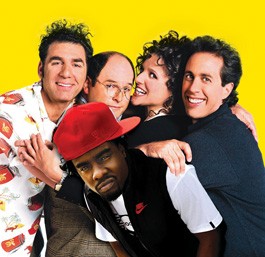Thirteen years ago, Jerry Seinfeld, Elaine Benes, George Costanza and Cosmo Kramer were sentenced to prison in the finale of Seinfeld. Since that final faux pas, the sitcom has grossed upwards of $2.7 billion in reruns and has popularized everything from shrinkage to PEZ. Its legacy looms large.
Most surprisingly, the sitcom about white, upper-middle-class Manhattanites created by Jerry Seinfeld—who appears at the Wells Fargo Center March 4—has influenced a handful of contentious musicians, and particularly rappers, who dwell on themes of racial and economic inequality. Since 1998, the “show about nothing” has been a constant inspiration for songs definitely about something.
A year after the show ended, Brooklyn rapper Jeru the Damaja titled a track about inner-city poverty “Seinfeld,” drawing chilling parallels to the sitcom’s “nothing” catchphrase and the fact that many African Americans, as in the final Seinfeld episode, end up in prison. In 2008, punk band Titus Andronicus dubbed its debut album—about existential and economic angst in blue-collar New Jersey—The Airing of Grievances, referencing a Costanza holiday tradition.
That same year, D.C. rapper Wale released the Seinfeld-centric Mixtape About Nothing, which found the black rapper sampling Kramer actor Michael Richards’ infamous onstage racial slurs and ruminating on the explosive n-word. He addresses a culture of racial discomfort and hypocrisy, stating: “When it’s us against all of them – They subconsciously low-talk us – And probably all think as Kramer did but still won’t talk it.” He then extends his argument from its us-vs.-them formula, stating that inside every black man “there’s a little bit of Kramer.”
Hip-hop artists Greg Nice, the Last Emperor and Lupe Fiasco have also referenced Seinfeld, and in his essay “I’m a Hustler, Homey; You a Customer Crony,” journalist John Perich argues that Seinfeld and gangsta rap “circle each other like yin and yang.” Perich writes that gangsta, with its law-skirting, crack-slinging, bling-earning protagonists, reintroduced the archetypal hustler to early-’90s America. The show of the same era trades on this very myth, he says, but since its characters belong to an economic “upper class,” they can’t be sympathetic hustlers. “Seinfeld only works in contrast to the hustler lifestyle: all of its jokes turn on successful people trying to hustle and failing.”
Patrick Stickles, lead singer of Titus Andronicus, tells me he recognizes “a few different socioeconomic ‘types’ on the show. George, the perpetually underemployed ne’er-do-well; Elaine, the long-suffering ladder climber; Jerry, the self-made, content and comfortable artisan; and Kramer, who we would nowadays identify as ‘Trustafarian.’.'”
For Stickles, the Seinfeld-ers’ perceived alienation isn’t due to race or social class; perhaps it’s part of what Perich calls their “culture of neuroticism and irony.”
“Their survival was certain, and another adventure was inevitably seven days away,” Stickles says, “yet they, like we, are filled with a certain emptiness, a great yearning. They would appear to have everything one could want, except for any sort of true and lasting happiness.”
Jon Stratton, professor of cultural studies at Curtin University, reads a different subtext. Stratton’s article “Seinfeld is a Jewish Sitcom, Isn’t It?” from his book Coming Out Jewish argues that the show trades not on Jerry & Co.’s elitism, but on their position as cultural outsiders. In a phone interview, he says the characters are “at sea in the civility of American-New York, white, middle-class life. It is their failure to assimilate successfully which provides the show’s humor.”
Of rap’s many Seinfeld references, rapper Greg Nice downplays his references. “What can I say?” he tells me. “I watch and like the show and it makes me laugh. I am a funny guy.”
However, Perich also says, “I’m really intrigued by what Wale is doing on the mix tape. What do you do when one of your icons just loses it like that? That’s one of the great things about music in general and hip-hop in particular: the ability to grapple both sides of an issue without having to present a definitive answer.” Stratton adds, “Richards’ racist outburst might, perhaps, be read as making plain the anxiety about race that pervades Seinfeld.”
Or maybe, Stickles says, it’s a product of their basic humanity. “You could even say that Seinfeld speaks powerfully to the sheer inability of human beings to ever be satisfied with their lot in life,” he concludes, “to the inescapability of the misery and anxiety that is just being alive.”
Jerry Seinfeld plays two completely sold-out shows on Friday, March 4, at the Wells Fargo Center. 50 Mark West Springs Road, Santa Rosa. 7pm and 9:30pm. $72-$92. 707.546.3600.











